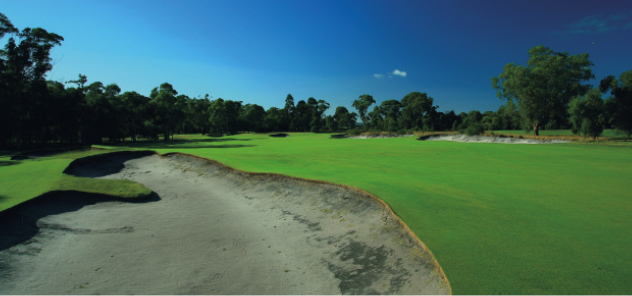
Metropolitan has changed dramatically over the past century but has never been short of plaudits. The club, the second oldest on the Melbourne sandbelt, was established in 1908. J. B. Mackenzie was one of the founding members, most of whom hailed from Royal Melbourne, and it was he who laid out the original course across some relatively flat farmland. Thousands of native trees and shrubs were planted beside fairways, and many of them still stand today, adding to the undeniable charm and character of the place.
Dr Alister MacKenzie made improvements to the bunkering and some of the greens during a visit in 1926. But the biggest alterations came in 1960 when the state government forced the club to sell part of its land for the construction of a school next door. American designer Dick Wilson was then commissioned to create seven new holes, and over the years these have blended nicely with the original layout. Further changes took place in 2006 when Mike Clayton rebuilt the 12th, 13th and 14th holes, while making modifications to a further six.
Today the design is revered. And not only that: Metropolitan has a reputation for having arguably Australia’s best playing surfaces. This has been known locally for decades, but it wasn’t until 2001 that the world started to take notice. When Metropolitan hosted that year’s World Match Play Championship it seemed like every player in the field was lining up to pay his respects. PGA Tour commissioner Tim Finchem summed up the feeling: ‘I’m not sure I recall being at one of our events in the last couple of years where every player in the field is just ecstatic about the quality and the condition of the golf course.’
Nearly a decade on, the high standards of Metropolitan’s pure couch fairways, leading into large and fast-rolling bent-grass greens, continue to impress. The 96 bunkers scattered throughout the course are well tended and a highlight of any round, adding to the test of your hitting and mental skills. And the back nine contains a string of impressive holes where top players have won and lost big championships in a heartbeat.
Two holes late in the round are a case in point. The par-four 16th, a 345-metre dogleg-right, has played a spoiler role in two Australian Opens. Bob Shearer in 1979, like Ian Baker-Finch seven years later, drove into one of four bunkers on the inside corner of the dogleg and made bogey. From there, any shot at winning was gone.
Pin positioning is the key. When the flag is tucked behind the right front bunker it is best to lay back on your tee shot, leaving a long, high-spinning second shot into the smallish green.
The par-four 18th, lengthened to a brutal 433 metres for the 1997 Australian Open, boasts a tough-to-read final green on which two titles have been lost . . . by the same man. A tier runs straight through the middle of the green, creating two distinct levels. In 1979 Greg Norman left his five-iron approach shot on the bottom level and three-putted for bogey, handing the championship to Jack Newton. Then, in a play-off in 1997, he did the same thing again from an almost identical position. Englishman Lee Westwood was the beneficiary.
Metropolitan is a private members’ club. Limited tee times are available for interstate and overseas visitors.
|
MEMORABLE HOLES 3rd, 5th, 8th, 12th, 13th, 16th and 18th WHERE TO GO Golf Rd, South Oakleigh, Victoria 3167 BOOK A ROUND (03) 9570 3774, www.metropolitangolf.com.au OTHER 120 GREAT COURSES NEARBY Huntingdale (1.8 km), Commonwealth (2.8 km), Yarra Yarra (3.1 km), Kingston Heath (6.2 km), Spring Valley (8.4 km), Victoria (9.2 km) WHERE TO STAY Melbourne’s CBD, less than 25 minutes away via the Monash Freeway, has accommodation options to suit all budgets. BEFORE/AFTER YOUR ROUND If you do stay in the city, jump on a tram headed for Melbourne Zoo. The zoo is Australia’s oldest, dating back to 1862, and has more than 350 animal species from around the world on display. |
